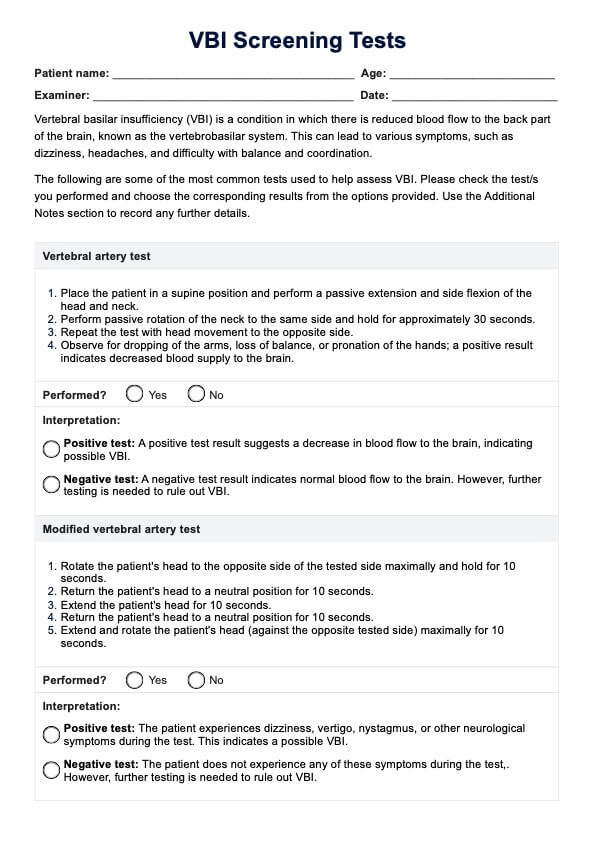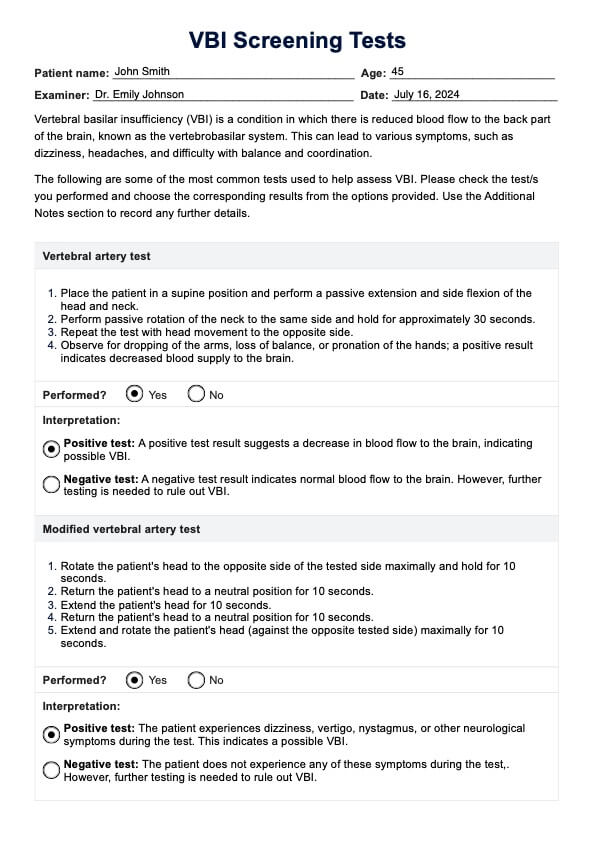VBI Screening Tests
Learn about VBI screening tests and access Carepatron's free PDF download to understand this important medical screening procedure better.


What is Vertebrobasilar insufficiency?
Vertebrobasilar insufficiency (VBI) refers to a condition characterized by decreased blood flow through the vertebral arteries, which supply the brainstem, cerebellum, and occipital lobes. These arteries, running through the cervical spine, are crucial for maintaining adequate blood flow to the posterior part of the brain. VBI often arises due to cervical arterial dysfunction, which can be exacerbated by factors such as cervical spine manipulation or compression.
Causes of vertebrobasilar insufficiency
VBI can stem from several underlying causes, primarily affecting the vertebral arteries that supply blood to the brainstem and cerebellum. Common triggers include cervical spine disorders such as cervical spondylosis, cervical spine trauma, or anatomical variations that impede normal blood flow.
Additionally, activities like cervical spine manipulation or prolonged neck positions can exacerbate VBI symptoms and transient ischaemic attack by compressing or compromising the vertebral artery's integrity.
Risk factors of vertebrobasilar insufficiency
Several factors increase the likelihood of developing vertebrobasilar insufficiency. Age plays a significant role, as older individuals are more prone to vascular changes and arterial stiffness. Conditions such as hypertension, diabetes, and hyperlipidemia contribute to vascular compromise, potentially leading to decreased blood flow through the vertebral arteries. Lifestyle factors like smoking and sedentary behavior can also exacerbate vascular health issues. Additionally, anatomical variations in the cervical spine or previous neck trauma increase the risk of VBI.
Symptoms of vertebrobasilar insufficiency
Symptoms of VBI may include dizziness, vertigo, diplopia, dysarthria, and transient ischemic attacks (TIAs). A patient tests positive for VBI when maneuvers like cervical spine rotation provoke symptoms due to compromised vertebral artery flow. Physical therapy plays a pivotal role in managing VBI, focusing on improving cervical spine stability and optimizing blood flow to the brain.
VBI Screening Tests Template
VBI Screening Tests Example
What are the VBI Screening Tests?
VBI screening tests are diagnostic procedures aimed at assessing the integrity and function of the vertebral artery, crucial for blood flow to the brainstem and cerebellum. These tests are vital for detecting conditions like vertebral artery insufficiency, often associated with cervical arterial dysfunction or decreased blood flow due to anatomical or functional issues in the cervical spine.
The following are some of the most common VBI tests:
Vertebral artery test
In this test, the patient should be placed in a supine position, followed by a passive extension and side flexion of the head and neck. Next, a passive rotation of the neck to the same side should be performed and held for about 30 seconds. This test should then be repeated with head movement to the opposite side. During these procedures, it is important to observe for any signs of dropping arms, loss of balance, or pronation of the hands, as a positive result would indicate a decreased blood supply to the brain.
A positive test result suggests a decrease in blood flow to the brain, indicating possible VBI. A negative test result indicates normal blood flow to the brain; however, further testing is needed to rule out VBI.
Modified vertebral artery test
In certain situations, a modified version of the vertebral artery test is used. The procedure involves rotating the patient's head maximally to the opposite side of the tested side and holding for 10 seconds, then returning the head to a neutral position for 10 seconds. Next, the patient's head is extended for 10 seconds, followed by another return to the neutral position for 10 seconds. Finally, the patient's head is extended and rotated maximally against the opposite tested side for 10 seconds.
A positive test occurs when the patient experiences dizziness, vertigo, nystagmus, or other neurological symptoms, indicating a possible VBI. Conversely, a negative test means the patient does not experience these symptoms, but further testing is needed to rule out VBI.
Extension rotation test
In thsi test, the procedure begins by positioning the patient in a supine lying position with the head above the edge of the table. The practitioner's role includes supporting the patient's head and then rotating it submaximally to one side, followed by bringing the head into extension. This position is maintained for 30 seconds, during which the practitioner engages the patient in conversation or has them count to 20 to observe for any changes in speech. Additionally, the practitioner monitors the patient's eyes for any signs of nystagmus.
A positive test occurs when the patient experiences dizziness, vertigo, nystagmus, or other neurological symptoms, indicating a possible VBI. Conversely, a negative test means the patient does not experience these symptoms, but further testing is required to rule out VBI.
How does this VBI Screening Tests template work?
Carepatron's free VBI Screening Tests template includes three most commonly used tests to screen for VBI and vertebral artery blood flow. Here's how to get started:
Step 1: Download the resource
Get a copy of the template using the link on this page. You can also find it in the Carepatron app or our resources library.
Step 2: Print or use the digital copy
You can either print the template or use it digitally on your device. We recommend using a tablet or laptop for better readability and ease of use.
Step 3: Follow instructions for each test
The template includes three different tests. You can conduct all three tests or choose the ones you need based on your patient's symptoms and medical history. Each test has step-by-step instructions for administering and interpreting the results.
Step 4: Record and save the results
Once you have completed the tests, record the results by choosing either positive or negative in the options provided. You can also add any additional notes or observations in the designated section. Save the template for future reference or to share with other healthcare providers involved in the patient's care.
Step 5: Discuss and take necessary action
Based on the results of the VBI Screening Tests discuss with your patient and determine whether further evaluation or treatment is necessary. Remember to always consider the patient's symptoms, medical history, and other relevant factors before making a diagnosis or recommending a course of treatment.
What are the next steps after using this template?
After utilizing the VBI Screening Tests template, healthcare practitioners should interpret the findings and determine appropriate next steps based on the results. If the screening indicates potential vertebrobasilar insufficiency, further diagnostic tests may be warranted to confirm the condition and assess its severity. These tests could include imaging studies such as MRI or CT angiography to visualize the vertebral arteries and evaluate blood flow.
Once a diagnosis is confirmed, treatment strategies can be tailored to the patient's specific needs. This may involve lifestyle modifications, medication to manage vascular health, or referral to specialists for advanced care. Follow-up assessments are crucial to monitor progress and adjust treatment plans as necessary. The ultimate goal is to optimize vertebral artery function, alleviate symptoms, and reduce the risk of complications associated with VBI.
Benefits of using our template
Our VBI Screening Template offers several advantages for healthcare practitioners conducting assessments for vertebrobasilar insufficiency (VBI). Here are three key benefits:
Standardized protocol for assessment
The template provides a standardized protocol for performing VBI screenings, ensuring consistency and reliability in assessments. It guides practitioners through essential maneuvers to evaluate vertebral artery function during cervical manipulations or rotations.
Comprehensive evaluation of blood flow
By incorporating screening tests and assessing both vertebral arteries, the template enables a comprehensive evaluation of blood flow to the brainstem and cerebellum. This thorough assessment is crucial for identifying potential issues such as compromised blood supply through the basilar artery or opposite vertebral artery.
Enhanced patient management and follow-up
Using our template supports improved patient management by facilitating early detection of VBI. Clinicians can promptly initiate appropriate interventions based on screening results, such as optimizing blood pressure management or recommending manipulative and physiological therapeutics.
How to manage and treat VBI?
Managing and treating vertebrobasilar insufficiency (VBI) involves several approaches aimed at improving blood supply to the brainstem and cerebellum. Initial steps include confirming the diagnosis through standardized VBI tests, assessing symptoms such as transient ischemic attacks (TIAs) or drop attacks, and evaluating blood flow through both vertebral arteries and collateral circulation pathways.
Treatment strategies may include manual therapy to address neck pain or stiffness, optimizing blood pressure management, and promoting cervical spine stability. Monitoring for warning signs during head movement or rotational activities is critical, as they can indicate compromised blood flow affecting the medulla oblongata.
Collaborative care involving manual therapists and healthcare providers ensures comprehensive management tailored to individual patient needs.
Commonly asked questions
The Vertebrobasilar insufficiency (VBI) test evaluates blood flow through the vertebral arteries to assess vertebrobasilar insufficiency, often provoked by cervical spine movements.
The 5 D's of vertebrobasilar insufficiency (VBI) include dizziness, diplopia (double vision), dysarthria (difficulty speaking), dysphagia (difficulty swallowing), and drop attacks (sudden falls).
The gold standard test for VBI is digital subtraction angiography (DSA), which provides detailed imaging of blood vessels to diagnose and assess blood flow abnormalities.
Vertebrobasilar insufficiency can be checked using maneuvers like the vertebral artery test, assessing symptoms triggered by cervical spine rotation to indicate compromised blood flow through the vertebral arteries.







































































































